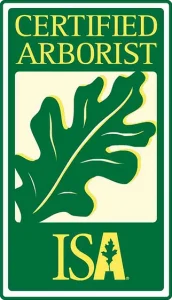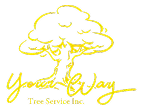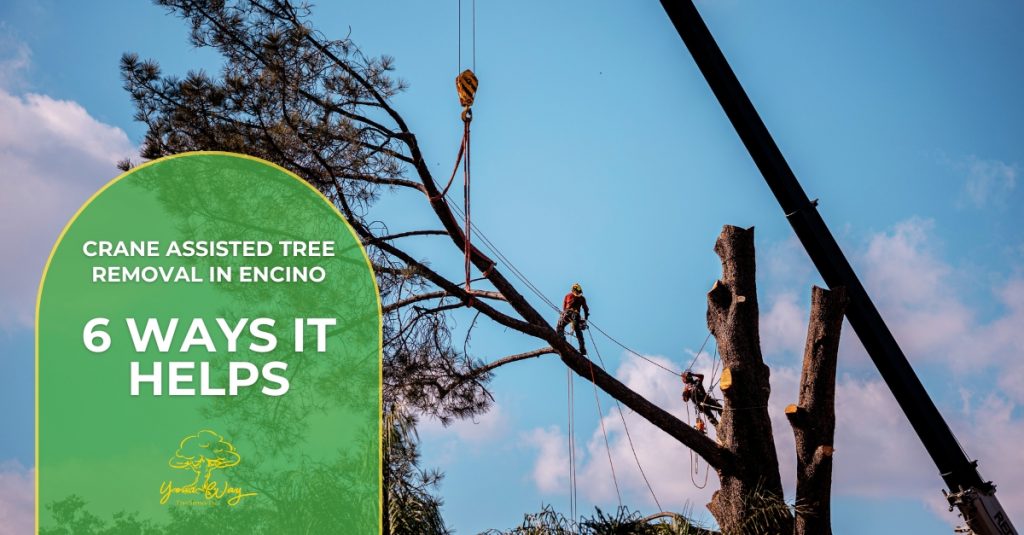When it comes to tree removal in Encino, traditional methods like climbing and cutting may not always be the safest or most efficient option. That’s where crane-assisted tree removal comes in.
This advanced technique uses heavy machinery to carefully dismantle trees, offering numerous benefits for both property owners and tree service professionals.
At Your Way Tree Service, we specialize in crane-assisted removals to handle large, hazardous, or hard-to-reach trees with precision. These are some of the ways this method can make tree removal safer, faster, and more effective.
1. Enhanced Safety for Workers and Property
Tree removal can be dangerous, especially when dealing with:
- Large, unstable trees
- Trees near power lines
- Trees with extensive decay or structural weaknesses
Crane-assisted removal minimizes the need for arborists to climb, reducing fall risks. The crane supports heavy limbs and trunks, preventing unexpected drops that could injure workers or damage property.
2. Minimized Impact on Surrounding Landscaping
Traditional tree removal often requires dropping large branches, which can:
- Crush plants, fences, or hardscapes
- Leave deep ruts from equipment
A crane allows controlled lifting and lowering of tree sections, protecting your lawn, garden, and other trees from unnecessary damage.
3. Faster and More Efficient Removal
Traditional tree removal methods—such as manual climbing, roping down branches, and cutting sections piece by piece—can take days, especially for large, mature trees. Crane-assisted removal, on the other hand, streamlines the process in several key ways:
How a Crane Speeds Up Tree Removal
- Lifts Entire Sections at Once
- Instead of cutting a tree into small, manageable pieces, a crane can lift large sections (sometimes entire trunks) in a single motion.
- This reduces the number of cuts needed, saving significant time.
- Eliminates the Need for Manual Lowering
- In traditional removals, arborists must carefully rope down branches to avoid damage.
- A crane simply lifts and lowers sections with precision, removing the time-consuming process of controlled drops.
- Reduces Ground Crew Labor
- Speeds up cleanup and minimizes physical strain on the crew.
- Ideal for Large-Scale Projects
- For commercial properties, multi-tree removals, or emergency storm cleanup, cranes drastically cut down project timelines.
For homeowners and businesses, this efficiency means less disruption and faster restoration of their property.
4. Ideal for Tight or Hard-to-Reach Spaces
Some properties may have limited space for traditional tree removal methods due to:
- Close neighbors
- Narrow yards
- Overhead obstructions (wires, roofs)
Cranes can extend over obstacles and remove trees without requiring extensive ground access, making them perfect for urban settings.
5. Reduced Risk of Property Damage
Dropping heavy limbs without control can lead to:
- Broken windows
- Damaged roofs
- Dented vehicles
Crane-assisted removal ensures precise placement of cut sections, eliminating accidental impacts.
6. Better Handling of Hazardous Trees
Some trees pose significant dangers that make standard removal methods too risky. Crane-assisted removal provides the safest solution for these hazardous situations by offering controlled, strategic dismantling. There are many reasons why this method excels where traditional techniques could fall short:
Types of Hazardous Trees Potentially Best Handled by Crane
- Severely Leaning Trees
- Trees leaning dangerously toward homes, power lines, or other structures
- Crane solution: The tree is secured and supported before any cuts are made
- Structurally Compromised Trees
- Trees with:
- Deep cracks or splits in the trunk
- Significant hollow sections
- Extensive decay (visible fungi or soft wood)
- Crane solution: Weight is supported before cutting to prevent sudden failure
- Trees with:
- Storm-Damaged Trees
- Trees with:
- Broken but hung-up limbs (“widow makers”)
- Split trunks still partially attached
- Root damage making them unstable
- Crane solution: Damaged sections are secured before removal
- Trees with:
- Trees in Confined Spaces
- Trees surrounded by:
- Buildings or structures on multiple sides
- Swimming pools or hardscapes
- Other valuable trees or landscaping
- Crane solution: Precise piece-by-piece removal without collateral damage
- Trees surrounded by:
The Crane Removal Process for Hazardous Trees
- Pre-Removal Assessment
- Certified arborists evaluate:
- Tree’s structural integrity
- Weight distribution
- Potential failure points
- Crane capacity and positioning determined
- Certified arborists evaluate:
- Controlled Dismantling
- Sections are cut in planned sequence:
- Typically top-down for safest weight management
- Large sections removed intact when possible
- Each cut is made only at the right time, typically after the crane has taken the load
- Sections are cut in planned sequence:
For hazardous tree removal in Encino, crane assistance isn’t just convenient – it’s often the safest option. The combination of engineering-grade equipment and certified arborist expertise ensures these dangerous jobs are completed without property damage or personal injury.
Experts for Safe, Efficient Tree Removal in Encino
Crane-assisted tree removal is a game-changer for homeowners and businesses dealing with large or hazardous trees. By combining advanced equipment with skilled arborists, we ensure the job is done safely, quickly, and with minimal disruption.
Our team is ready to handle even the most challenging tree removals with precision and care. If you think there’s even a chance you may need professional tree removal in Encino or throughout the surrounding area, contact Your Way Tree Service today for a free estimate.



No Comments
Be the first to start a conversation